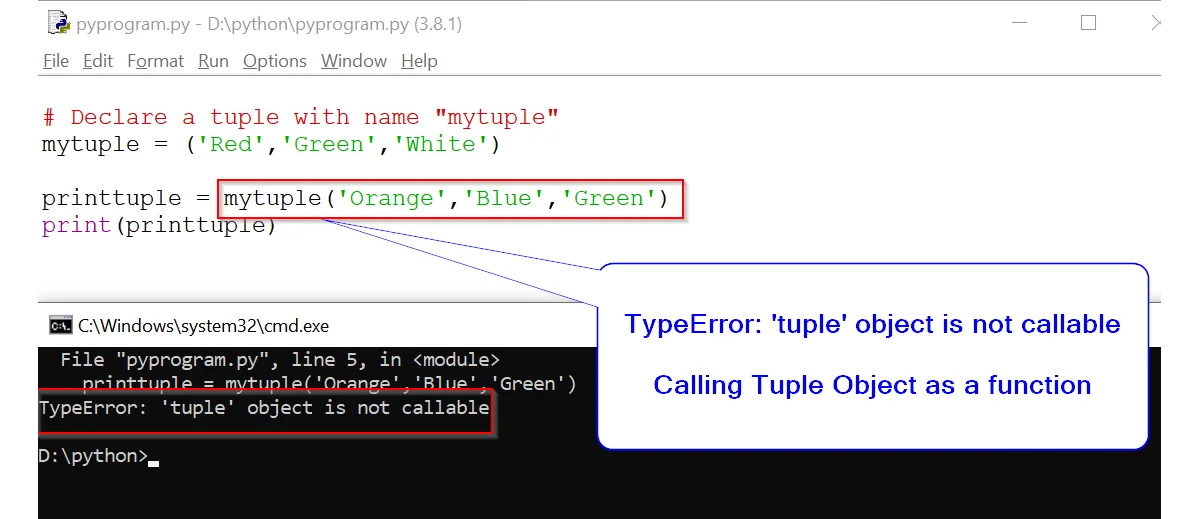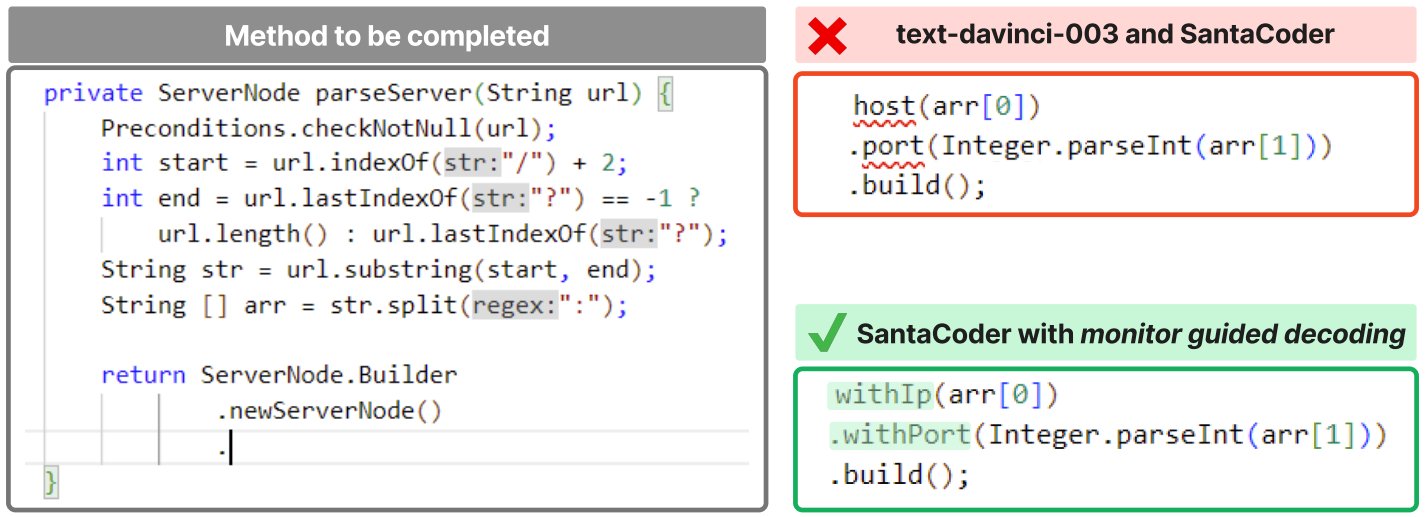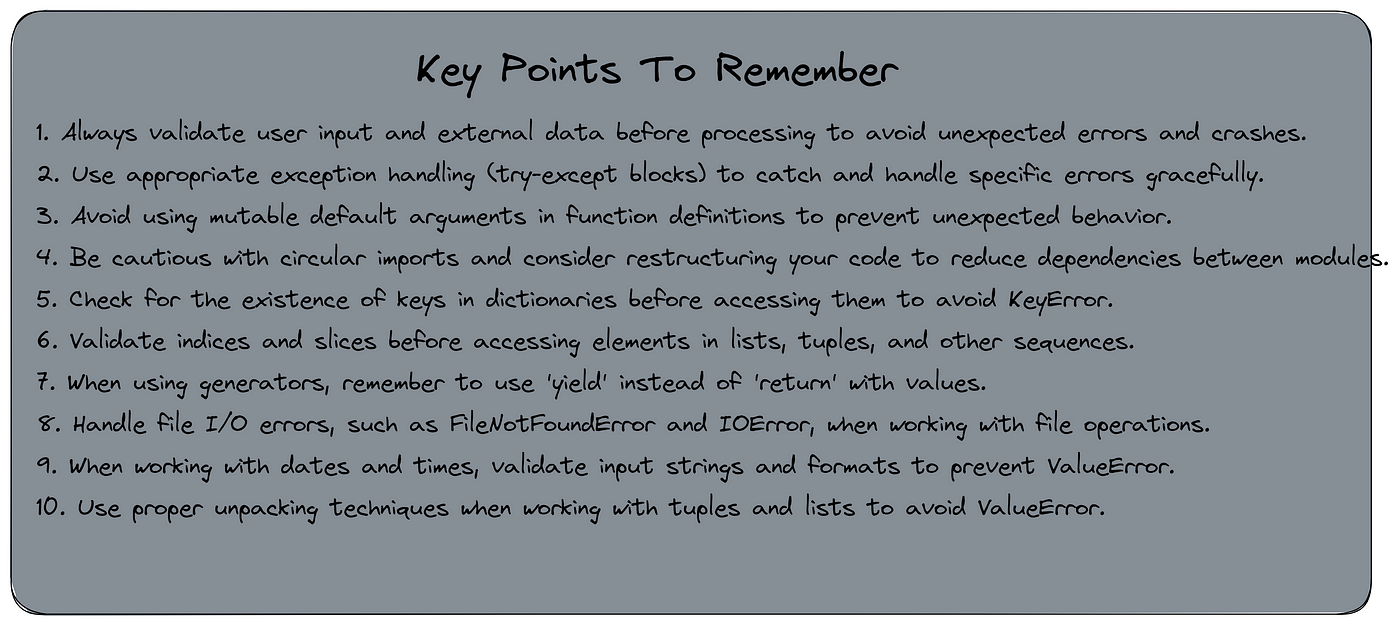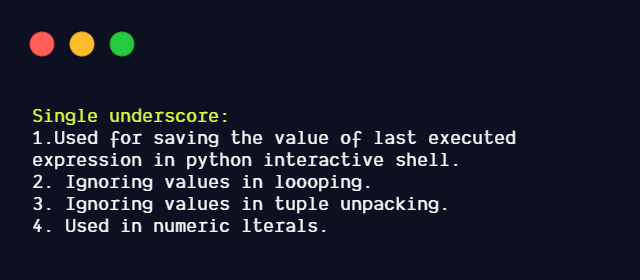Typeerror: ‘Tuple’ Object Is Not Callable
Overview of the TypeError: ‘tuple’ object is not callable
The TypeError: ‘tuple’ object is not callable is a common error that occurs in Python when a tuple object is mistakenly used as if it were a function or method. In Python, a tuple is an immutable sequence type, which means it cannot be modified once created. It is often used to store related pieces of information together.
When the error message “‘tuple’ object is not callable” is encountered, it means that a tuple object is being called or used as a function, but tuples are not callable in Python. This error can be frustrating for beginner programmers, but it can be resolved by understanding the concept of tuples and identifying the causes of the error.
Understand the Concept of Tuples in Python
A tuple in Python is a collection of ordered, immutable elements enclosed in parentheses. Elements in a tuple can be of different data types, such as integers, strings, or even other tuples. Tuples are similar to lists but are immutable, which means the values within a tuple cannot be modified.
Here’s an example of creating a tuple in Python:
“`
my_tuple = (1, 2, 3, “a”, “b”, “c”)
“`
In the above example, we have created a tuple with six elements, including integers and strings.
Explaining Callables in Python
In Python, a callable is an object that can be called or invoked like a function. This includes built-in functions, user-defined functions, methods, and certain classes. Callables can be recognized by using parentheses after the object name.
Here’s an example of calling a built-in function in Python:
“`
print(“Hello, World!”)
“`
In the above example, the `print` function is a callable, and we call it by using parentheses followed by the arguments.
Understanding the Difference between Callable and Non-Callable Objects
While callables can be invoked as functions, non-callable objects cannot be used in the same way. Tuples, being immutable sequences, are non-callable objects. Therefore, attempting to call a tuple object as if it were a function will result in the TypeError: ‘tuple’ object is not callable.
Identifying the Causes of the TypeError: ‘tuple’ object is not callable
There are several common scenarios that can lead to the TypeError: ‘tuple’ object is not callable error. By understanding these scenarios, you can quickly identify the cause of the error and troubleshoot it effectively.
Scenario 1: Attempting to Call a Tuple Object
One common cause of the error is mistakenly trying to call a tuple object as if it were a function. For example:
“`
my_tuple = (1, 2, 3)
result = my_tuple()
“`
In the above code, `my_tuple` is a tuple object, and attempting to call it results in the TypeError.
Scenario 2: Mistakenly Assigning a Tuple to a Callable Variable
Another common cause is mistakenly assigning a tuple to a variable that is expected to be a callable object. For example:
“`
my_tuple = (1, 2, 3)
my_function = my_tuple
result = my_function()
“`
In the above code, `my_function` is expected to be a callable object, but it is assigned a tuple instead.
Scenario 3: Incorrect Syntax in Code that Results in the Error
Syntax errors can also lead to the TypeError: ‘tuple’ object is not callable error. For example:
“`
my_tuple = (1, 2, 3)
result = my_tuple(1, 2, 3)
“`
In the above code, the incorrect placement of parentheses after `my_tuple` causes the error.
Troubleshooting the TypeError: ‘tuple’ object is not callable
Once the cause of the TypeError: ‘tuple’ object is not callable error is identified, there are several solutions to resolve it and prevent it from occurring in the future.
Solution 1: Review and Correct the Code Logic
If you are attempting to call a tuple object, review your code logic and ensure that you are using the correct callable objects. If the tuple is not meant to be callable, remove the parentheses or modify your code accordingly.
Solution 2: Verify Variable Assignments and Reassign if Necessary
If you have mistakenly assigned a tuple to a variable used as a callable object, verify the variable assignments and correct them as needed. Ensure that variables used as callables are assigned appropriate functions or methods.
Solution 3: Double-Check Syntax and Correct any Errors
If the error is caused by incorrect syntax, carefully review your code and check for any syntax errors, such as misplaced or missing parentheses. Double-check your code and correct any syntax errors that may be causing the TypeError.
Tips for Avoiding and Preventing the TypeError: ‘tuple’ object is not callable
To prevent encountering the TypeError: ‘tuple’ object is not callable error in your Python code, consider the following tips:
Tip 1: Carefully Review Code Before Execution
Before executing your code, thoroughly review it and check for any potential errors or inconsistencies. Pay attention to variable assignments and ensure that callables are appropriately assigned.
Tip 2: Use Descriptive Variable Names to Avoid Confusion
Use descriptive variable names that clearly indicate their purpose and type. This will help avoid confusion and prevent mistakenly using non-callable objects as if they were callables.
Tip 3: Test Code in Small Chunks to Catch Errors Early
When writing code, test it in small chunks or increments to catch errors early. This will allow you to identify and resolve any issues before they become more challenging to debug.
By understanding the concept of tuples, recognizing the difference between callables and non-callable objects, and troubleshooting the causes of the TypeError: ‘tuple’ object is not callable error, you can write more robust and error-free Python code.
FAQs
Q: What does the error message “‘tuple’ object is not callable” mean in Python?
A: The error message “‘tuple’ object is not callable” indicates that a tuple object is being used or called as if it were a function. Tuples are immutable and non-callable objects in Python, so attempting to call them will result in this error.
Q: How can I avoid the TypeError: ‘tuple’ object is not callable error?
A: To avoid this error, carefully review your code before execution, use descriptive variable names, and test your code in small chunks to catch errors early. Understand the concept of callables and non-callable objects, and ensure that you are using the appropriate objects in your code.
Q: What are some common programming errors related to this TypeError?
A: Some common programming errors related to the TypeError: ‘tuple’ object is not callable include mistakenly attempting to call a tuple object, mistakenly assigning a tuple to a callable variable, and syntax errors that result in the error message.
Typeerror: ‘Tuple’ Object Is Not Callable | Django Error | Simple Errors |
Why Is Tuple () Not Callable In Python?
When working with Python, it is essential to understand the various data structures available, as well as their capabilities and limitations. One of the built-in data structures in Python is the tuple. Tuples are similar to lists, but they have some distinctive characteristics. One peculiar limitation of tuples is that they are not callable.
In Python, a callable object refers to any object that can be called like a function. It means that the object can be followed by a pair of parentheses, and it will execute some code or perform some action. Functions, methods, and classes are typical examples of callable objects. However, this is not the case with tuples.
Tuples are immutable sequences, which means they can’t be modified after creation. They are typically used to store a collection of items that should not change. For instance, a tuple can be used to represent a point in a two-dimensional space, coordinates in a map, or a record in a database. The elements within a tuple can be of different types, including numbers, strings, or even other tuples.
To create a tuple, we use parentheses and separate the elements with commas. For example:
my_tuple = (1, 2, ‘hello’, (3, 4))
Once a tuple is created, we can access its elements using indexing, just like with lists. For example, my_tuple[0] would return the first element, which is 1. We can also use other common operations such as slicing, concatenation, and len() to retrieve information from or manipulate the tuple.
However, when we try to call a tuple as if it were a callable object, an error occurs. For example:
my_tuple()
This code will raise a TypeError, indicating that the tuple object is not callable. This limitation is due to the characteristics and use case of tuples within Python.
FAQs:
Q: Can I modify a tuple after it is created?
A: No, tuples are immutable, so their elements cannot be modified or rearranged after creation. To modify a tuple, you would need to create a new tuple with the desired changes.
Q: How is a tuple different from a list?
A: Tuples and lists in Python are both used to store collections of items, but they have some differences. Tuples are immutable, while lists are mutable. This means that tuples cannot be modified after creation, whereas lists can have elements added, removed, or changed. Additionally, tuples are typically used for heterogeneous collections of items, while lists are more often used for homogeneous collections.
Q: Why would I use a tuple instead of a list?
A: Tuples are useful when you want to ensure that a collection of items remains unchanged. They can be used as keys in dictionaries because they are immutable. Furthermore, tuples are more memory-efficient than lists, as they require less overhead. If you have a collection of items that you know should not change, using a tuple is a good choice.
Q: Can I use a tuple with a for loop?
A: Yes, you can use a tuple with a for loop to iterate over its elements. For example:
my_tuple = (1, 2, 3)
for item in my_tuple:
print(item)
This code would print each element of the tuple on a separate line.
Q: Are tuples only used for simple data structures?
A: No, tuples can be nested to create more complex data structures. You can have tuples inside tuples, forming a hierarchy of data. This allows you to represent multi-dimensional data or hierarchical structures.
In conclusion, tuples in Python are a convenient way to store collections of items that should remain unchanged. Although tuples share some similarities with lists, they have distinct characteristics. One important limitation of tuples is that they are not callable. Understanding this limitation is crucial for avoiding errors and utilizing tuples correctly in Python programming.
What Is A Tuple Error?
Errors are an integral part of programming that occur when the code encounters a situation it cannot handle. These errors are typically displayed as error messages and can sometimes be cryptic, especially for novice programmers. One common type of error is the Tuple Error, which occurs when there is an issue with tuples in a program. In this article, we will explore the concept of tuple errors, their causes, and provide some guidelines on how to handle them effectively.
Understanding Tuples
Before delving into tuple errors, let us first understand what tuples are. In programming, a tuple is an ordered collection of elements that can be of different types. These elements are enclosed within parentheses and separated by commas. Tuples are immutable, meaning their values cannot be modified once they are created. They are commonly used to group related data together.
Causes of Tuple Errors
1. Index Out of Range:
This error occurs when trying to access or reference an element of the tuple using an index that does not exist. Indexing in tuples, as in most programming languages, starts from zero. Consequently, trying to access an element at an index greater than or equal to the length of the tuple results in an index out of range error.
2. Assigning to Tuple Items:
Since tuples are immutable, attempting to modify the value of an item within a tuple will result in a tuple error. For instance, trying to assign a new value to an existing tuple element will raise an error.
3. Mismatched Tuple Sizes:
When working with tuples, it is essential to ensure that tuples of the same size are used together. If, for example, you are attempting to combine two tuples of different sizes, a tuple error will occur. The sizes of the tuples must match for successful operations like concatenation or unpacking.
4. Incorrect Tuple Syntax:
Programming languages have specific rules for defining tuples. Violating these rules, such as missing the necessary commas or parentheses, will result in a tuple error. Therefore, it is crucial to ensure correct syntax when declaring tuples.
Handling Tuple Errors
Now that we have identified some causes of tuple errors, let’s explore some strategies for handling them effectively:
1. Understanding the Error Message:
When encountering a tuple error, it is crucial to carefully read the error message. This message often provides valuable information about the specific cause of the error. Analyzing the error message helps to pinpoint the issue and enables programmers to take corrective actions.
2. Index Validation:
To avoid index out of range errors, always double-check the index value before accessing a tuple element. Ensure the index is within the valid range of the tuple size.
3. Tuple Unpacking:
When working with tuples, particularly during assignments, ensure that both sides receive the same number of elements. Tuple unpacking expects the same number of variables on either side of the assignment statement. Mismatching the count may result in a tuple error.
4. Correcting Tuple Syntax:
When declaring or initializing tuples, it is essential to adhere to the proper syntax defined by the programming language. Check for missing/inappropriate commas or parentheses that may lead to tuple errors.
Frequently Asked Questions
Q1. Are tuple errors specific to a particular programming language?
No, tuple errors can occur in any programming language that supports tuples. However, the specific error messages may vary across different programming languages.
Q2. Can tuple errors be fixed easily?
The ease of fixing a tuple error depends on the cause. Some tuple errors, like index out of range, can be resolved by verifying the index value. Others, like assigning to tuple items or mismatched tuple sizes, may require code modification or restructuring.
Q3. Can tuple errors be prevented entirely?
While it is impossible to prevent all tuple errors, following best programming practices can significantly reduce the likelihood of encountering them. This includes careful validation of indices, correct tuple syntax, and ensuring compatibility between tuple sizes when performing operations.
Q4. Can tuple errors be handled using exception handling mechanisms?
Yes, most programming languages provide exception handling mechanisms that allow for graceful handling of tuple errors. By capturing and handling tuple-specific exceptions, programmers can provide custom error messages or perform alternative actions to improve code resilience.
In conclusion, tuple errors occur when there are issues with tuples in a program. These errors can be caused by index out of range, assigning to tuple items, mismatched tuple sizes, or incorrect tuple syntax. By understanding the causes and following best practices, programmers can effectively handle tuple errors and write more robust code.
Keywords searched by users: typeerror: ‘tuple’ object is not callable TypeError tuple object is not callable pandas, List’ object is not callable, Transform list to tuple python, Convert string list to tuple Python, Input tuple in Python, List to tuple Python, Tuple shape, Df shape 0 pandas
Categories: Top 59 Typeerror: ‘Tuple’ Object Is Not Callable
See more here: nhanvietluanvan.com
Typeerror Tuple Object Is Not Callable Pandas
When working with pandas, you might come across an error message that says “TypeError: ‘tuple’ object is not callable”. This error typically occurs when you try to call a tuple object as if it were a function or a method.
In this article, we will delve into the reasons behind this error, explore common scenarios where it can occur, and provide solutions to overcome it. So, let’s get started!
Understanding the TypeError: ‘tuple’ object is not callable
To understand this error, we need to understand the basics of tuples in Python. Tuples are immutable data structures that contain a collection of elements. They are created by enclosing values within parentheses and separating them with commas.
Pandas is a popular data manipulation library in Python, widely used for data analysis and manipulation tasks. It provides powerful data structures such as DataFrames, which are essentially two-dimensional tables, and Series, which are one-dimensional labeled arrays.
However, it’s not uncommon to encounter situations where you mistakenly try to call a tuple as a function or method from within pandas, resulting in the TypeError: ‘tuple’ object is not callable.
Scenarios where the TypeError can occur
1. Parentheses confusion:
One common scenario where this error occurs is when you mistakenly use parentheses that resemble a function call instead of square brackets for indexing or slicing an object. For example:
“` python
import pandas as pd
data = pd.DataFrame({‘Column1’: [1, 2, 3, 4]})
# Incorrect – Using parentheses instead of square brackets
column_data = data(‘Column1’)
“`
In the above example, the incorrect usage of parentheses instead of square brackets triggers the error. Remember, square brackets are used for indexing and slicing, whereas parentheses are used for function calls.
2. Assigning function output to a tuple:
Another common scenario is when you mistakenly assign a function’s output to a tuple object, thinking it was a callable method. Let’s consider an example:
“` python
import pandas as pd
data = pd.DataFrame({‘Column1’: [1, 2, 3, 4]})
# Correct – Assigning function’s output to a DataFrame
column_data = data[‘Column1’]
# Incorrect – Assigning function’s output to a tuple
column_data_tuple = data(‘Column1’),
“`
In the above example, the incorrect assignment of the function’s output to a tuple triggers the TypeError. Instead, we should assign the function’s output to a DataFrame, as shown in the correct line.
Solutions to overcome the ‘tuple’ object not callable error
1. Use square brackets for indexing and slicing:
To resolve this error, ensure that you are using square brackets for indexing and slicing operations on pandas objects. For example:
“` python
import pandas as pd
data = pd.DataFrame({‘Column1’: [1, 2, 3, 4]})
# Correct – Using square brackets
column_data = data[‘Column1’]
“`
By using square brackets, you can extract the desired columns or rows from a DataFrame.
2. Check function calls:
Double-check your code for any function calls. Ensure that you are using the correct syntax by using parentheses only when calling functions or methods. For example:
“` python
import pandas as pd
data = pd.DataFrame({‘Column1’: [1, 2, 3, 4]})
# Correct – Calling the head() method
first_five_rows = data.head(5)
# Incorrect – Using parentheses instead of square brackets
first_five_rows_tuple = data.head(5),
“`
In the above example, the incorrect usage of parentheses instead of square brackets triggers the TypeError. Make sure to only use parentheses for function calls.
FAQs about TypeError: ‘tuple’ object is not callable in pandas
Q1. What does the error message ‘tuple’ object is not callable mean?
A1. This error typically occurs when you try to call a tuple object as if it were a function or a method.
Q2. How can I fix the TypeError: ‘tuple’ object is not callable in pandas?
A2. To fix this error, ensure that you use square brackets for indexing and slicing operations instead of parentheses, and double-check for any incorrect function calls.
Q3. Can this error occur with other data types in pandas?
A3. No, this specific error is exclusive to tuple objects and their incorrect usage within pandas.
Q4. Can I convert a tuple to a callable object in pandas?
A4. No, tuples are immutable in Python, and you cannot convert them to callable objects. You need to modify your code logic to avoid this error.
In conclusion, the TypeError: ‘tuple’ object is not callable may occur when mistakenly calling a tuple object as if it were a function or method within pandas. By using the correct syntax, such as square brackets for indexing and slicing, and ensuring proper function calls, you can overcome this error and continue working with pandas effectively.
List’ Object Is Not Callable
Introduction
The ‘List’ object is an essential data structure in Python programming language, allowing programmers to store and manipulate collections of data efficiently. However, it is not uncommon for beginners and even experienced programmers to encounter the error message “List’ object is not callable.” This error can be frustrating, and understanding its cause and how to resolve it is crucial for effective coding. In this article, we will delve into the meaning of this error, explore its potential causes, and provide practical solutions to overcome it.
Understanding the Error: ‘List’ object is not callable
When encountering the error message “‘List’ object is not callable,” it typically occurs when attempting to treat a list as if it were a function. More specifically, this error arises when the code tries to call (execute) a list object as it would a function, which is not a valid operation in Python. In essence, lists are not callable entities, and attempting to use them as such will result in the error message.
Causes of the Error
1. Incorrect Syntax: In Python, parentheses () are used to invoke callable objects, such as functions. If you mistakenly use parentheses when intending to access a list value, it will lead to the ‘List’ object is not callable error.
2. Reassignment: Another common cause of this error is reassigning a list variable to a different data type. If a list is mistakenly assigned a different value, such as an integer or a function, subsequent calls to the variable as a list will result in the error.
3. Name Conflicts: The error can also occur when a variable is assigned the same name as an existing function. In such cases, calling the variable with parentheses will trigger the error because Python will attempt to access the function with that name rather than the intended list variable.
Common Examples
To provide a clearer understanding of when and how this error occurs, here are a few examples:
Example 1:
“`
my_list = []
my_list() # Incorrect usage – will trigger the error
“`
Example 2:
“`
len = [1, 2, 3]
len() # Incorrect usage – assigning ‘len’ as a list and then trying to call it like a function
“`
Example 3:
“`
def sum(x, y):
return x + y
my_list = sum
my_list() # Incorrect usage – reassigning ‘my_list’ as a function and then trying to call it
“`
Resolving the Error
1. Validate Syntax: Carefully review the code for any accidental misuse of parentheses, ensuring they are used appropriately depending on the desired operation. Double-check that list variables are not mistakenly treated as functions.
2. Check Variable Assignments: Verify that list variables are not inadvertently reassigned to a new value of a different type, such as a function or an integer.
3. Avoid Naming Conflicts: To prevent conflicts with function names, use distinctive variable names and avoid reusing names. This practice enhances code readability and minimizes the risk of encountering the ‘List’ object is not callable error.
FAQs – Frequently Asked Questions
Q1. What does the error message “‘List’ object is not callable” mean?
A1. This error occurs when trying to treat a list (a data structure) as if it was a function (a callable object). Lists cannot be called or executed using parentheses, causing this error.
Q2. How can I avoid the ‘List’ object is not callable error?
A2. To prevent this error, ensure that parentheses are used correctly, especially when invoking functions. Additionally, be cautious when reassigning list variables and avoid naming conflicts with functions.
Q3. Can I call a function inside a list?
A3. Yes, it is possible to include functions inside lists as elements. However, to execute or call the functions, you need to access them using indexing or iteration rather than calling the list itself.
Conclusion
The ‘List’ object is not callable error is a common obstacle encountered by Python programmers. Knowing the causes and how to resolve this error is essential for writing efficient code. By understanding the fundamental difference between lists and functions and practicing mindful coding, you can minimize the occurrences of this error. Remember to double-check syntax, handle variable assignments accurately, and avoid naming conflicts. By following these guidelines, you will be well-equipped to tackle this error effectively and improve your Python programming skills.
Images related to the topic typeerror: ‘tuple’ object is not callable

Found 21 images related to typeerror: ‘tuple’ object is not callable theme






![Solved] TypeError: 'str' object is not callable - Python Pool Solved] Typeerror: 'Str' Object Is Not Callable - Python Pool](https://www.pythonpool.com/wp-content/uploads/2022/04/TypeError-str-object-is-not-callable.webp)

























Article link: typeerror: ‘tuple’ object is not callable.
Learn more about the topic typeerror: ‘tuple’ object is not callable.
- TypeError: ‘tuple’ object is not callable in Python [Fixed]
- Python TypeError: ‘tuple’ object is not callable Solution
- TypeError: ‘tuple’ object is not callable in Python (Fixed)
- ‘tuple’ object is not callable: Causes and solutions in Python
- TypeError: ‘tuple’ object is not callable in Python (Fixed)
- Python AttributeError: ‘tuple’ object has no attribute – LearnDataSci
- TypeError: module object is not callable [Python Error Solved]
- 2 Causes of TypeError: ‘Tuple’ Object is not Callable in Python
- How to fix TypeError: ‘tuple’ object is not callable in Python
- django: TypeError: ‘tuple’ object is not callable – Stack Overflow
- TypeError ‘tuple’ object is not callable – STechies
- TypeError: ‘tuple’ object is not callable in Python – Its Linux FOSS
- Typeerror: ‘tuple’ object is not callable – Itsourcecode.com
See more: nhanvietluanvan.com/luat-hoc